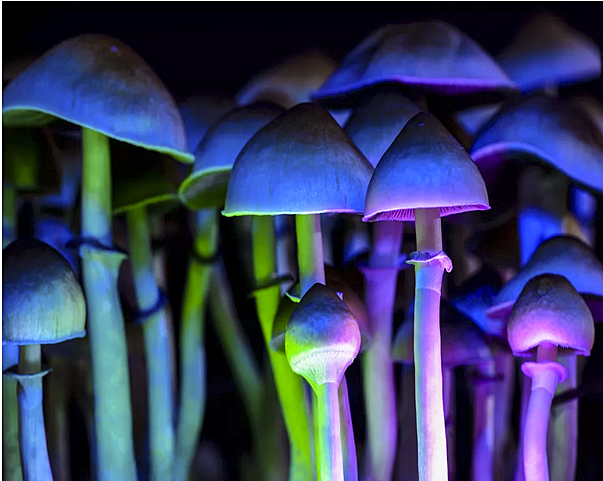
- Articles
‘Plants of the Gods’ and their hallucinogenic powers in neuropharmacology — A review of two books by Miguel A. Faria, MD
PART I: A Sorcerer’s Apprentice — The Teachings of Don Juan
I discovered the tome, Plants of the Gods: Their Sacred, Healing, and Hallucinogenic Powers [11], while researching and ascertaining the veracity of certain stories contained in an immensely celebrated series of books from the sixties and seventies by Carlos Castaneda, an anthropology student and PhD candidate at the University of California at Los Angeles (UCLA).[4] I wanted to verify the existence and corroborate the action of the powerful hallucinogenic plants mentioned in that popular series and that were consumed by Don Juan, the teacher, and Carlos Castaneda (“Carlito”), his younger apprentice.
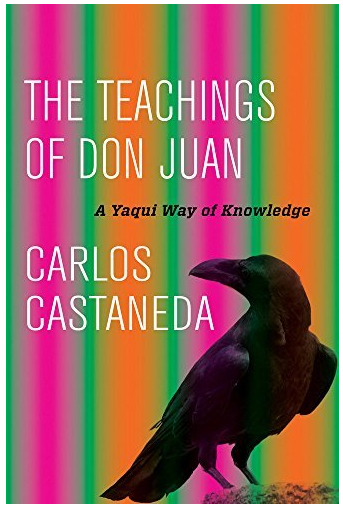
According to Castaneda, Don Juan was a Yaqui Indian sorcerer from the Sonora desert area of Mexico, who accepted Castaneda as a student and took him under his tutelage for several years. The apprenticeship entailed the repeated and ritualistic use of hallucinogenic plants to assist Carlito in becoming “a man of knowledge,” a sorcerer and warrior, like his mentor Don Juan. The plants were categorized by Don Juan as “teachers” or “allies,” and would lead Carlito to reach a state of non-ordinary reality, a separate realm of reality.
By reaching a separate reality and becoming a sorcerer or warrior, Carlito would escape the mundane everyday existence that most of us lead and become inaccessible to old friends and family. As a man of knowledge in the state of non-ordinary reality, Carlito would attain vast amounts of supernatural powers by which he could then carry out extraordinary feats — such as fly great distances, converse with animals, render enemies harmless, vanquish powerful foes, and accept death without fear when it came.
Much of this information evolved over time in Castaneda’s subsequent books, but his first three books, written while he was still an anthropology student, became a sensation that catapulted the author to stardom. His first book, The Teachings of Don Juan: A Yaqui Way of Knowledge (1969),was in fact his thesis for his PhD in anthropology. It was published by a university press and then republished by a commercial publisher with titanic commercial success. His other books quickly followed, but it was in the first book that he described the use and preparation of hallucinogenic plants utilized in his quest for knowledge.
After attaining fame and commercial success, Castaneda remained mysterious and inaccessible, a secretive man in all aspects of his life, while orchestrating from afar a vast following of admirers, students, and apprentices. Questions were asked and are still being asked about his anthropological apprenticeship, the veracity of his research, the existence of Don Juan, and the logical question of whether his PhD should have been given in anthropology or creative writing!
Suffice to say that since the 1970s the literary reference to the persona of Don Juan shifted almost imperceptibly in America from the amorous Don Juan of Spanish literature to Don Juan Matus, the Yaqui sorcerer, “man of knowledge,” and mentor of Carlos Castaneda. (The reader should keep in mind that it is in fact Carlos Castaneda himself who is speaking through the persona of Don Juan and who is expounding his purported philosophy of life in all of his books.)
In reading the next book, Plants of the Gods: Their Sacred, Healing, and Hallucinogenic Powers by ethnobotanists, Richard Evans Schultes, Albert Hofmann and Christian Rätsch, I found that the descriptions of the three main hallucinogenic plants Castaneda dealt with were largely accurate and the observations about the preparation and use of drugs perceptive. Moreover, because of their effects and toxicity, these plants and the psychoactive drugs they produce should be of interest to neuroscientists as well as neuropsychiatrists — from researchers in the laboratory to drug addiction and rehabilitation experts as well as neurologists and psychiatrists, especially professionals on call to emergency rooms since drug enthusiasts may present with acute seizures, delirium, delusions, or frank psychotic states.
Two plants in Don Juan’s armamentarium were considered “allies”: Psilocybe mexicana, a mushroom that was dried and smoked in a pipe and referred to as humito (“little smoke”) by Don Juan; and Jimsonweed or devil’s weed, a powerful psychoactive plant in the Nightshade family. The species utilized, Datura innoxia, was chewed and ingested or rubbed as an ointment to certain body parts. Both the smoked mushroom (humito) and the flowering plant Datura, also referred to as devil’s trumpet and Moonflower, helped the ritualistic consumer in his journey to attain a state of non-ordinary reality and wield supernatural powers.
A third hallucinogenic plant was the most powerful and, as a benevolent “teacher,” a deity in and of itself. Don Juan referred to this plant as mescalito. The plant not only assisted the user in reaching a separate reality but also taught great lessons that would lead to a better ordinary life. The source was peyote, Lophophora williamsii, a cactus species grown in Mexico and the American southwest. The top part of the cactus was cut off, collected, and dried. Later these peyote “buttons” were ritualistically chewed and ingested, a couple of pieces at a time. Don Juan and Carlito participated in several such ceremonies described in the early books.[4]
But before I go into detail about the ethnobotany and neuropharmacology discussed in Plants of the Gods and the implications for neuropsychiatry,[5,7] I want to satisfy the SNI reader’s curiosity: Why bring the controversial Carlos Castaneda and his books into neuropharmacology? I preemptively reply with another question: Is there any other cultural term that, for some individuals, has changed so dramatically as the literary reference to the persona of “Don Juan”?
Before the advent of Carlos Castaneda in the 1960s, “Don Juan” was indelibly associated with the amorous, fictitious and devilish libertine brought to life by the 17th century Spanish dramatist, Tirso de Molina. Don Juan has continued to occupy a central place in Spanish literature, been immortalized in the play Don Juan Tenorio by Jose Zorrilla, and celebrated in all of Western literature in the poetry of Lord Byron. But for many American baby boomers of the 1960s, “Don Juan” conjures up images of Castaneda’s Don Juan Matus, the Yaqui sorcerer from the Sonora desert.
And let me just give you another example. Castaneda’s books were so popular in their day that American director, film producer and screenwriter Oliver Stone named his movie production company, Ixtlan Productions (2007), after Castaneda’s third book, Journey to Ixtlan. So why not mix a little literature with ethnobotany and neuropharmacology?
During my college days, I did not have time to read Carlos Castaneda’s books and learn about Don Juan’s Yaqui way of knowledge. Frankly, I was too busy with pre-med courses to read those books, although the temptation was there. Castaneda’s books with their appropriately colorful covers were arranged, front and center, in stacks at my college bookstore in the Russell House, the epicenter of student culture on the University of South Carolina campus in Columbia, South Carolina.
Now 50 years later, following the Aristotelian philosophy of the good life by spending time in my garden as well as reading the classics, I finally found time to read Castaneda’s entertaining series and check the veracity concerning hallucinogenic drugs and neurochemistry.
PART II: “Plants of the Gods”
“Plants of the Gods” is a term referring to the religious meaning members of many primitive cultures worldwide attribute to plants containing hallucinogenic or mind-altering substances. The plants are customarily considered sacred, and consumed in religious rituals in an attempt to reach and communicate with gods or revered ancestors. They are frequently used in healing rites. Occasionally, they are used for purely recreational purposes, this being their main use in the modern societies of both industrialized and underdeveloped nations. However, it must be noted that the hallucinogenic or psychedelic experiences, although recreational, are not always euphoric.
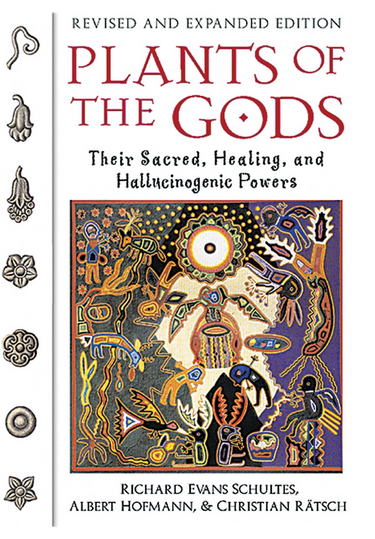
Plants of the Gods: Their Sacred, Healing, and Hallucinogenic Powers is well-written, fully illustrated with color photographs, and contains a good index. It is an effective compilation of ethnographic, historic, and neuropharmacologic information on the hallucinogenic plants of planet Earth and the psychological and sociological impact they have, particularly in primitive societies. The book could have been better organized in terms of grouping plants by their pharmacologic effects rather than cataloguing them in alphabetical order. Additional ethnographic chapters do significantly enhance the narrative and compensate for the cataloguing sections. All things considered, the authors have done a splendid job researching the plants and bringing forth associated ethnographic information.
Most of the hallucinogenic substances contained in these plants are toxic, but for the most part follow the principle of hormesis[6] — first enunciated by the 16th century German-Swiss physician Paracelsus (1493-1541) and that states that the dose makes the poison. Nevertheless, some psychoactive drugs are toxic even in small doses and can be fatal in larger doses. Seizures, acute psychotic states, transient neurologic deficits, delirium, delusions as well as permanent psychosis with lapses into chronic vegetative states and death are not rare in some of these cultures.
The behavioral side effects and toxic manifestations that may be associated with transient or permanent neurological deficits or psychiatric conditions place them in the realm of neuropsychiatry, when affected individuals present to the emergency room or are referred for medical consultation.
I have tried to classify the plants according to their pharmacologic mode of action. But an encyclopedic book of this magnitude with hundreds of plants is a difficult task so I have selected a few of the major groups containing the most interesting plants with similar neuropharmacology to give this book fair exposure.
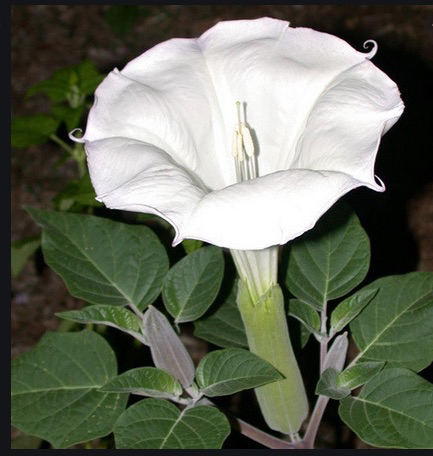
The Nightshade plants and the tropane alkaloids
The Nightshade flowering plants (Solanaceae family) have been known in Europe since the Middle Ages because of their long history of use in witchcraft and divination. The major plants in this family include Mandrake (Mandragora officinarum), Henbane, Belladonna (Atropa belladonna; deadly nightshade), and several Datura species, such as Thorn Apple (Datura stramonium) and Datura innoxia, “Devil’s Trumpet,” which we have already mentioned as devil’s weed and Jimsonweed. I have also heard it referred to as Moonflower.[Figure 1]
Belladonna, mandrake and henbane come from Mediterranean Europe and North Africa. During the Middle Ages, all three plants were used or were implicated for their use in witches brew and imbued with magic powers and used in potions or ointments in both witchcraft and healing rituals. In the 11th century the defending Scots annihilated an invading Norwegian army by sending them food and beer laced with “Sleepy Nightshade” (Belladonna). The Mandrake root that resembles a human figure was particularly feared (a good example of imitative magic) for its hypnotic and hallucinogenic properties, as well as for its lethality as a poison in higher doses.[Figure 2] In South America, species of the genus Brugmansia (“Angel’s trumpet”)are gathered by Amazonian Indians for their hallucinogenic properties and used in rituals and for curative purposes.
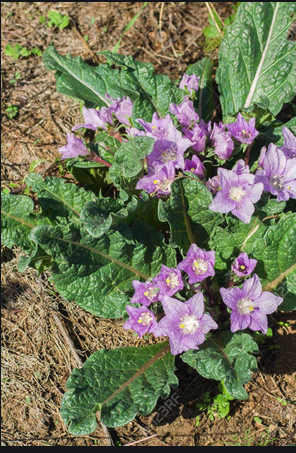
Previously, we mentioned Datura innoxia in the context of the teachings of Don Juan. Datura plants grow in the tropical and subtropical regions of both hemispheres. In Mexico, the plants, referred to as Toloache, are considered one of the main plants of the gods and used extensively for their psychoactive effects. It was consumed by both the Mayans and the Aztecs in ancient times. The eminent Maya scholar Eric Thompson wrote in The Rise and Fall of Maya Civilization[12] that the chilans (Mayan priests specializing in divination) may have used peyote and Datura mixed with tobacco and lime to induce hallucinatory visions and assist them in divination. More recent archeological and anthropological scholarship has confirmed that bloody Mayan rituals also utilized hallucinatory plants.[10]
The present-day Tarahumara Indians of Mexico mix Datura plants (Toloache) with maize to make a ceremonial drink. Furthermore, they believe that Toloache is possessed by a malevolent spirit, just as Don Juan, the Yaqui teacher, also believed.
The active principles in the Nightshade plants are the chemicals atropine, scopolamine (a potent hallucinogenic tropane alkaloid), hyoscyamine, and other tropane alkaloids. These alkaloids are present in fresh plants and their dried roots, and have toxic effects because of their anticholinergic (i.e., nausea, vomiting, tachycardia, paralysis, etc.) and strong psychoactive effects (i.e., hallucinations, delusions, psychosis, seizures etc.).

The Cactus Peyote and the catecholamine derivatives
Cacti (Cactaceae; cactus family) were so named by Theophrastus (371-287 BC), naturalist and philosopher successor to Aristotle in the Peripatetic School, after a spiny plant now lost. The main cactus in this category we have already mentioned — peyote (Lophophora williamsii) — a cactus that grows in Mexico and Texas in the driest of desert regions.[Figure 3] As instructed by Don Juan in the preparation of mescalito, Mexican Indians today also cut off the head of the cacti (crown), collect them in bags, dry them, and then ingest them in rituals for the hallucinogenic effects that are said to be kaleidoscopic and vivid in color. There is a period of euphoria or contentment followed by calmness and introspection. Unlike Datura that is supposed to be possessed by a malevolent spirit, peyote is purportedly a benevolent entity. These plants continue to be used by indigenous Americans for religious rites as well as medicinal and healing ceremonies (veladas) conducted by Mexican shamans (curanderos).
There are also false peyote species that are widely used by the Tarahumara Indians because these cacti are also hallucinogenic. The active principle in peyote is mescaline (3,4,5-trimethoxyphenylethylamine) a psychoactive phenylethylamine, related to the neurotransmitter norepinephrine (as well as to the catecholamines dopamine, a neurotransmitter, and epinephrine, a hormone).

Therefore, mescaline acts as a sympathomimetic drug that mimics the effects of the catecholamines, the endogenous agonists of the sympathetic nervous system mentioned above, which can act as CNS neurotransmitters or systemic hormones.

The mushroom Psilocybe and the indole alkaloid derivatives
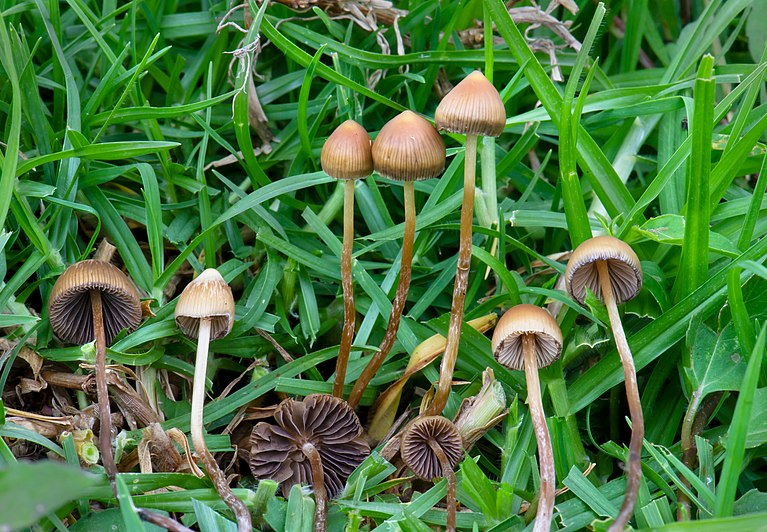
The mushrooms (Strophariaceae family) of the genus Psilocybe are a third group of hallucinogenic plants. There are many Psilocybe species, and they are found nearly worldwide, but ethnographically are centered in Mexico, where they are nearly venerated by various indigenous groups.[Figure 4] Mexican curanderos frequently refer to them as magical mushrooms. We have already mentioned Psilocybe mexicana in reference to Don Juan’s sacred humito, the great teacher of sorcerers in reaching a separate or alternate reality. This species grows at higher altitudes in limestone areas, along trails in meadows and fields.
The Aztecs called these mushrooms Teonanácatl (“divine flesh”), and as we have mentioned, the Mayans also ingested them, although peyote may have been the most commonly used hallucinogen in both civilizations, as well as by most other Mesoamerican cultures.
Psilocybe cyanescens, the wavy cap mushroom species, have a wavy brown cap but unlike Psilocybe mexicana, grows in decaying plants, “coniferous mulch, and humus-rich soil.” Reportedly, it has been used in neo-pagan rites in Central Europe and North America. “Visionary doses are 1 gm of the dried mushroom, which contains approximately 1% tryptamine (e.g., psilocybin(e) and psilocin(e).”[11]
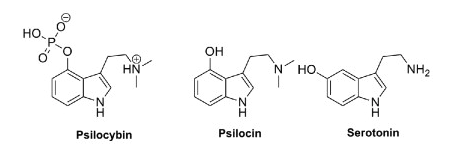
The active principles in these mushrooms — i.e., psilocybin and psilocin — are indole alkaloids, related to tryptamine and the neurotransmitter serotonin (5-hydroxy tryptamine), of which the amino acid tryptophan is a precursor. Serotonin is the neurotransmitter that regulates mood, and psilocybin and its derivative psilocin are psychoactive compounds that are lipid soluble — i.e., lipophilic and thus capable of easily crossing the blood brain barrier. Therefore they are potent hallucinogens.

The tryptamine compounds are very structurally (and functionally) similar to serotonin. They bind at the 5-HT receptors, acting as serotonin agonists and mimicking the psychoactive properties of serotonin in the central nervous system (CNS). The primary action is mood enhancing, as to cause happiness and euphoria.[9]
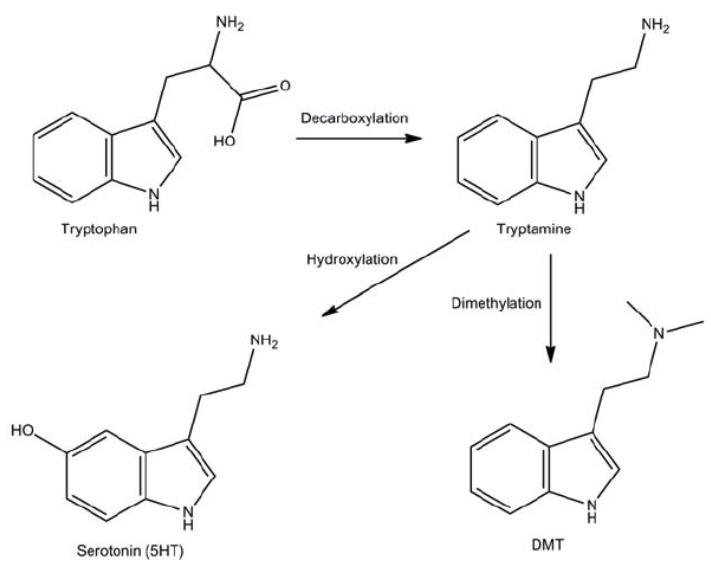
Lysergic acid derivatives are also indole alkaloids related to serotonin, and the powerful semi-synthetic hallucinogen LSD (lysergic acid diethylamide) also binds 5-HT and even some dopamine receptors acting as serotonin and dopamine agonists, mimicking and amplifying the psychoactive properties of these neurotransmitters in the CNS, inducing the well-described psychedelic effects reported by users. The exact mechanism of how it happens is unknown.[9]
In Mexico, several varieties of morning glories (Turbina corymbosa) referred to as Ololiuqui and bindweed vines (Ipomoea violacea) are considered sacred plants because of their hallucinogenic powers. Both the Zapotec and Aztec Indians consumed the seed of these plants containing lysergic acid compounds that also act via the serotonin psychoactive pathways, as with psilocybin and psilocin. They continue to be used for religious and curing rituals by modern Indians throughout Mexico, including the Mazatecs and the Zapotecs in the Oaxaca region.
In the Orinoco river basin between Colombia and Venezuela, the Guahibo Indians use a powerful tobacco snuff, Cohoba, which is hallucinogenic, and to which the local Indians refer to as Yopo. It had been recorded by Spanish explorers as early as 1496 that Cohoba may have been brought by the Taino Indians of the Caribbean and used as a snuff mixed with tobacco to communicate with the spirit world from earlier times. Cohoba comes from the beans of the Yopo tree, Anadenanthera peregrina, that was part of the flora studied by the German naturalist Baron Alexander von Humboldt (1769-1859) in the early 1800s.
The Guahibo Indians take Yopo snuff (Cohoba) in the course of the day as a stimulant, “while their shamans use it to induce trances to communicate with the Hekula spirits to prophesize or divine; to protect the tribe against epidemics of sickness; to make hunters and even their dogs more alert.”[11] (The book contains a series of photographs documenting a ceremony in which the powder is blown forcibly into the nostril of the Indians and the hallucinogenic sequence that follows.)
The active principle in the chemistry of the Yopo tree (Anadenanthera) derivatives are the open and close rings of the tryptamine (indole alkaloids) neurochemicals related to serotonin.
Incidentally, plants are not the only source of psychoactive substances. Toads, frogs, and certain fish have been described as containing tryptamine compounds in their secretions. For example, bufotenine, an open tryptamine found in the Anadenanthera tree, is secreted in the skin of a Bufo species of toad.[11]
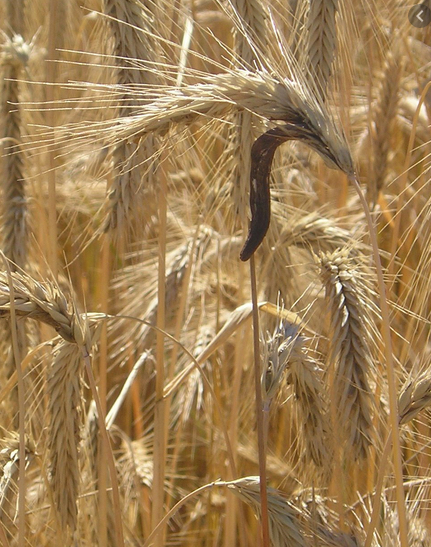
The fungus Claviceps purpurea and Ergot poisoning
The ergot fungus, Claviceps purpurea, is found in temperate areas of Europe, Asia, and North America. Ergot is a parasitic disease of grasses and sedges, principally rye. (Claviceps stands for the fungus sclerotium, or spur, attached to the infected grain).[Figure 5] During the Middle Ages, rye was used for making bread, and inadvertently the ergot infecting the kernels were milled into the flour with the result that ergotism ensued, killing hundreds. Outbreaks were referred to as St. Anthony’s Fire because of the burning sensation of the affected limbs due to the intense vasoconstriction of vessels supplying limbs and brain, causing gangrene and madness. Incidentally, St. Anthony was a hermit in Egypt c. AD 350 who went on to live to age 105 and was aptly named the patron saint of fire, epilepsy, and infection. The first outbreak of “Holy Fire” broke out during the First Crusade and it was in France that the first hospital to treat victims was founded along with the Order of St. Anthony in the 11th century.
In ergot poisoning the active principles are again indole alkaloids derivatives —i.e., ergotamine and ergotoxine — that cause severe vasoconstriction responsible for ergotism and gangrene. Other psychotropic lysergic acid amides are responsible for the convulsions, delirium, and madness. Amazingly, these psychotropic derivatives are similar to those found in Mexican morning glories and bind weeds previously mentioned.[11]
Recent investigations suggest that psychotropic ergot derivatives may have played a role in the Eleusinian mysteries of ancient Greece. It has been found that ergotamine and ergotoxine, the chemicals responsible for the worse toxic effects of ergotism, are insoluble. Therefore, an initiate would drink a measured volume of the sacred mixture of water with ergot-contaminated barley and other wild grasses, and because the milder psychoactive alkaloids (i.e., lysergic acid derivatives) are water-soluble, he would have visions while drinking the infusion, but not get ergotism. The hallucinogenic mechanism is suspected to be similar to what we have described with the indole alkaloid derivatives, serotonin and lysergic acid derivatives.
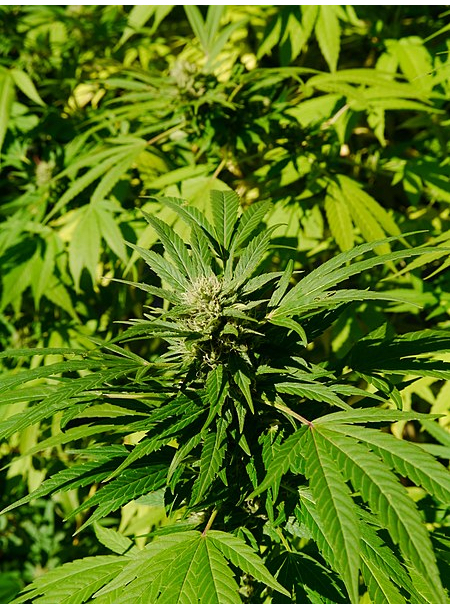
Cannabis sativa, Opium, and Cocaine
In the Hemp family, Cannabis sativa, is a plant that is grown worldwide and is known as hashish, hemp, weed, marijuana, and by a myriad other names.[Figure 6] It produces the psychoactive drug tetrahydrocannabinol (THC), a drug that is well known in the popular culture. Cannabis relaxes and causes euphoria, but it can also cause spatial distortions and trigger hallucinations. It is said, and the authors seem to agree, that Cannabis heightens awareness and enhances creativity. In fact, it appears to be the least dangerous of all the psychedelic and hallucinogenic drugs described in the book.
Nevertheless, marijuana can have adverse side effects that are well known to physicians — from gynecomastia to chronic respiratory infections. In chronic users, it can also predispose to anxiety and depression or aggravate chronic psychotic disorders, including schizophrenia. This should not be surprising as chronic psychotic disorders, particularly schizophrenia, involve several neural pathways that involve microglia activation and inflammation[2] that may be triggered by repeated use of the drug in sensitive individuals. Frequent use of cannabis during adolescence has been found to deleteriously affect brain development and cause cognitive deficits.[8] Notwithstanding these concerns, marijuana has been legalized in many American states for medical use.
Hemp (marijuana) was mentioned by the Greek geographer and historian Strabo (c. 63 BC-AD 21) in his Geography as growing in Colchis in Scythia, and he referred to “Getae dancers who burned cannabis flowers to reach states of ecstasy.”[3] The Greek physician and botanist Dioscorides (AD 40-90) cites hemp as a source of fiber for making textiles and recommends it as treatment for earache. The great Greek physician and surgeon Galen (AD 130-200) notes that hempseed was added to sweet foods in banquets to induce euphoria and arousal.[3]
The exact mechanism of how THC acts to alter mood and cognition and other psychogenic effects is not known, but it is known that the drug induces its most powerful effects by binding to its own cannabinoid receptors in the brain and that additional psychotropic effects may take place by the indirect release of dopamine.[13]
Another group of plants that should be mentioned for the sake of completeness are the opioids closely related to the narcotics. If the book, Plants of the Gods: Their Sacred, Healing, and Hallucinogenic Powers, is deficient in one area, it is in the brief description of narcotics and cocaine. This could be related to the fact that narcotics produce euphoria but are generally not hallucinogenic. In fact, morphine, a well-known narcotic drug produced from the opium poppy plant, is named after the Greek god of sleep, Morpheus, because of its hypnotic qualities — in the same fashion as the scientific name of the opium poppy plant itself, Papaver somniferum.
We should also mention the drug cocaine, extracted from the leaves of two coca species of plants (Erythroxylaceae coca), it is also a tropane alkaloid. Coca plants grow in western South America, and it is a cash crop for several countries in the region — e.g., Bolivia, Colombia, Ecuador, Peru, and parts of Argentina. It is an indirect sympathomimetic drug that crosses the blood-brain barrier and blocks the transport of dopamine, serotonin, and norepinephrine, inhibiting the re-uptake of these neurotransmitters at the presynaptic terminals, thus increasing their quantity, as well as the activation of the receptors in the postsynaptic neurons. This intense agonist activation results in the well-known effects of cocaine intoxication — euphoria, tachycardia, sexual arousal, agitation, and loss of contact with reality, which can result in frank psychotic states.[1] Dependence and tolerance are additional problems as with the narcotics.
Cocaine has been used by South American Indians for hundreds of years, from the time of the Incas to their present-day descendants in the Andean region. Chewing the leaves helps them combat hunger, fight inclement weather, ease fatigue, and alleviate altitude sickness.
Conclusion
I recommend Plants of the Gods: Their Sacred, Healing, and Hallucinogenic Power with the following caveat: The book was published 20 years ago, and during that time many advances have been made in the area of neuropharmacology.[1] The tome still makes good reading for enthusiasts, as well as a secondary reference source for neuropsychiatrists, neurologists, sociologists, anthropologists, and neuropharmacology medical researchers.
I also recommend The Teachings of Don Juan: A Yaqui Way of Knowledge. In fact, Carlos Castaneda’s first four books make delightful, recreational reading by offering a form of escapism. But make no mistake, Castaneda’s books should be read as works of fiction, except for the accurate description of the hallucinogenic drugs and their effects contained in his first book, The Teachings of Don Juan. Otherwise, read them for pure enjoyment and entertainment.
References
1. Azizi SA. Monoamines: dopamine, norepinephrine, and serotonin, beyond modulation, “switches” that alter the state of target networks — A review article. Neuroscientist. December 9, 2020. Available from https://journals.sagepub.com/doi/10.1177/1073858420974336 [Last accessed on 4 June 2021].
2. Blaylock RL. Inflammation, immunoexcitotoxicity and microglia activation in schizophrenia. HaciendaPublishing.com, January 31, 2018. Available from: https://haciendapublishing.com/inflammation-immunoexcitotoxicity-and-microglia-activation-in-schizophrenia-by-russell-l-blaylock-m-d/ [Last accessed on 4 June 2021].
3. Carod-Artal FJ. Psychoactive plants in ancient Greece. Neuroscience and History. 2013;1(1): 28-38. Available from https://nah.sen.es/vmfiles/abstract/NAHV1N1201328_38EN.pdf [Last accessed on 4 June 2021].
4. Castaneda C. The Teachings of Don Juan: A Yaqui Way of Knowledge. 3rd ed. Berkeley and Los Angeles, CA: University of California Press; 2008 (1st ed., 1969); Castaneda C. A Separate Reality: Further Conversations with Don Juan. 1st ed. New York, NY: Simon & Schuster; 1971; and Castaneda C. Journey to Ixtlan: The Lessons of Don Juan. 1st ed. New York, NY: Simon & Schuster; 1972.
5. Faria MA. Frontal lobe syndromes in neuropsychiatry – A book review. Surg Neurol Int 16-Dec-2020;11:439. Available from: https://surgicalneurologyint.com/surgicalint-articles/frontal-lobe-syndromes-in-neuropsychiatry-a-book-review/ [Last accessed on 4 June 2021].
6. Faria MA. Glyphosate, neurological diseases – and the scientific method. Surg Neurol Int 10-Aug-2015;6:132. Available from: https://surgicalneurologyint.com/surgicalint-articles/glyphosate-neurological-diseases-and-the-scientific-method-2/ [Last accessed on 4 June 2021].
7. Faria MA. The neuropsychiatry of the limbic system — A book review. Hacienda Publishing.com, July 27, 2015. Available from: https://haciendapublishing.com/a-book-review-of-the-neuropsychiatry-of-limbic-and-subcortical-disorders/ [Last accessed on 4 June 2021].
8. McKenna J. The long-term side effects of marijuana use. Reviewed by Arzt N. WebMD.com, December 12, 2020. Available from https://www.webmd.com/connect-to-care/addiction-treatment-recovery/marijuana/long-term-effects-marijuana-use [Last accessed on 4 June 2021].
9.Nichols DE. Hallucinogens. Pharmacology & Therapeutics. 101 2004; (2): 131–81. Available from: https://www.sciencedirect.com/science/article/abs/pii/S0163725803001657?via%3Dihub [Last accessed on 4 June 2021]; and Nichols DE. The end of a chemistry era… Dave Nichols closes shop. November 2012. Available from https://www.erowid.org/culture/characters/nichols_david/nichols_david_interview1.shtml [Last accessed on 4 June 2021].
10. Schele L, Miller ME. Blood of Kings: Dynasty and Ritual in Maya Art. New York, NY: George Braziller; 1986.
11. Schultes RE, Hofmann A, and Rätsch C. Plants of the Gods: Their Sacred, Healing, and Hallucinogenic Powers. 2nd ed. Rochester, VT: Healing Arts Press; 2001.
12. Thompson JES. The Rise and Fall of Maya Civilization. Norman, OK: University of Oklahoma Press; 1954. p. 250.
13. Wilson RI, Nicoll RA. Endocannabinoid signaling in the brain. Science. 2002;296 (5568): 678–8.2. Available fromhttps://web.archive.org/web/20200226195416/https://pdfs.semanticscholar.org/ff97/28733e790c394791321d9b9b079dacb7c01d.pdf [Last accessed on 4 June 2021].
Written by Dr. Miguel Faria
Miguel A. Faria, M.D. is Associate Editor in Chief in socioeconomics, politics, medicine, and world affairs of Surgical Neurology International (SNI). Clinical Professor of Surgery (Neurosurgery, ret.) and Adjunct Professor of Medical History (ret.) Mercer University School of Medicine. Author of Cuba in Revolution: Escape From a Lost Paradise (2002). His most recently released book is America, Guns, and Freedom: A Journey Into Politics and the Public Health & Gun Control Movements (2019).
This article may be cited as: Faria MA. ‘Plants of the Gods’ and their hallucinogenic powers in neuropharmacology — A review of two books. HaciendaPublishing.com, June 15, 2021. Available from: https://haciendapublishing.com/plants-of-the-gods-and-their-hallucinogenic-powers-in-neuropharmacology–a-review-of-two-books-by-miguel-a-faria-md
Copyright ©2021 Miguel A. Faria, Jr., M.D.
7 thoughts on “‘Plants of the Gods’ and their hallucinogenic powers in neuropharmacology — A review of two books by Miguel A. Faria, MD”
Great book(s) review.
Mystical Castaneda Quote: Intent is what sends a shaman through a wall, through space, to infinity.
Practical Castaneda Quote: Will is what can make you succeed when your thoughts tell you that you’re defeated.
This is an extremely insightful concept. Stated the first way, it seems arcane and fanciful — magical thinking (something Castaneda knew quite a bit about). Stated the second way, it makes perfect sense to all “warriors” without regard to their cultural foundations. The Japanese warrior ethos (bushido) labels this concept as tamashii — indomitable spirit. Where the rubber meets the road (ie philosophy meets physical reality), it is one of a small handful of truly determinative personality traits. It is masculine/positive (Yo/Yang) energy. In equilibrium with a few other attributes it forms the foundation for Fudoshin, a soul which cannot be unbalanced. Of course, these are all ideals to which we aspire, and this is the true nature of a fully conscious person’s life (a constant striving toward integrity). All philosophy (including theology and psychology) should be examined within this context. Otherwise, these discussions become absurd.
Dr. Morrow, thank you for your additional insights on cultural diversity on the concept of the “indomitable spirit.”
This is an excellent review, and very comprehensive. It is too comprehensive to tackle all of it in one small comment!
So, I would just like to mention Belladonna. The full name of the plant is Atropa Belladona, and that might give away one of it’s main medical uses to some… an extract of the plant is used as the anticholinergic Atropine. Perhaps not as much as it used to be, but it was of great use to ophthalmologists to dilate the pupils during an ophthalmoscopic examination. It was also used by psychiatrists and neurologists to treat disorders of movement, either primary (idiopathic) or secondary to antipsychotic poisoning. We know that as an anticholinergic, it creates a functional overload of dopamine, which might be desired in the basal ganglia, but not in the mesolimbic system. Atropine’s effects on the mesolimbic system are likely responsible for the hallucinogenic properties of Nightshade, and do bear slight resemblance to some mental illnesses, but in mental illness, auditory hallucinations would predominate.
Nightshade also was used in bygone eras to poison enemies and former lovers. One could extract Hyoscine,
Hyoscyamine, and Atropine from crude preparations of this plant without too much trouble in the Victorian era. But they have highly similar molecular configurations, so forensic scientists worked hard in those days to develop a test to differentiate which one(s) of the three were actually used. To convict in a court of law required demonstrating which were employed, as was done in the infamous December 1910 London trial of Dr. Harvey Crippen.
But I digress….. I might have a tangent for every one of the drugs mentioned! Thanks for the great read.
ARB
In the late 1700s, a large percentage of Europeans feared the tomato. A nickname for the fruit was the “poison apple” because it was thought that aristocrats got sick and died after eating them, but the truth of the matter was that wealthy Europeans used pewter plates, which were high in lead content. Because tomatoes are so high in acidity, when placed on this particular tableware, the fruit would leach lead from the plate, resulting in many deaths from lead poisoning. No one made this connection between plate and poison at the time; the tomato was picked as the culprit.
Around 1880, with the invention of the pizza in Naples, the tomato grew widespread in popularity in Europe. But there’s a little more to the story behind the misunderstood fruit’s stint of unpopularity in England and America, as Andrew F. Smith details in his The Tomato in America: Early History, Culture, and Cookery. The tomato didn’t get blamed just for what was really lead poisoning. Before the fruit made its way to the table in North America, it was classified as a deadly nightshade, a poisonous family of Solanaceae plants that contain toxins called tropane alkaloids.
One of the earliest-known European references to the food was made by the Italian herbalist, Pietro Andrae Matthioli, who first classified the “golden apple” as a nightshade and a mandrake—a category of food known as an aphrodisiac. The mandrake has a history that dates back to the Old Testament; it is referenced twice as the Hebrew word dudaim, which roughly translates to “love apple.” (In Genesis, the mandrake is used as a love potion). Matthioli’s classification of the tomato as a mandrake had later ramifications. Like similar fruits and vegetables in the solanaceae family—the eggplant for example, the tomato garnered a shady reputation for being both poisonous and a source of temptation. (Editor’s note: This sentence has been edited to clarify that it was the mandrake, not the tomato, that is believed to have been referenced in the Old Testament)… https://getpocket.com/explore/item/why-the-tomato-was-feared-in-europe-for-more-than-200-years?utm_source=pocket-newtab
If you want to learn more read https://getpocket.com/explore/item/7-poisonous-mushrooms-and-what-happens-if-you-eat-them?utm_source=pocket-newtab — FYI for my mushroom-foraging friends! — El Brujo.
There are also good mushrooms. “There is some great eating out there in the fungal world, and some of the best-tasting mushrooms are also quite safe, with no or few poisonous look-alikes. But every mushroom article must carry a warning, so here goes: While only about two Americans are killed by consuming poisonous mushrooms each year, many hundreds suffer everything from mild gastrointestinal distress to liver failure from eating “bad” mushrooms. The rule of thumb is to not eat any mushroom without being 100 percent sure that it’s safe to eat. For beginners, that means running your find past an expert. The good news is that there are local mushroom hunting groups that can educate you almost everywhere that mushrooms grow. The other thing to remember is that virtually all mushrooms are at least mildly poisonous in their raw form and must be cooked before they’re eaten.” — https://getpocket.com/explore/item/the-7-safest-mushrooms-to-forage-and-eat?utm_source=fbsynd&utm_medium=social&fbclid=IwAR3N3QjYtfIXJ7z1hYrDyPLcuj5BjxF3XHPpWrUfJK_O4qQMzZD8_pu8AXM
More wild mushrooms you can eat, according to experts (I am not!): https://www.youtube.com/watch?v=2jsIf_0_1eA